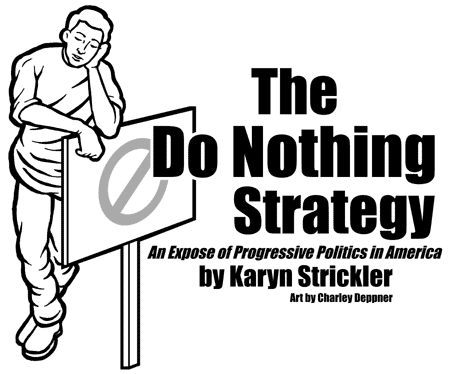Donate to IMPACT
Click below for info


• The Do-Nothing Strategy
• Quickies
(music reviews)
 • E-Mail Comments
• Archives
• Subscribe to IMPACT
• Where to Find
IMPACT
• Buy IMPACT T-Shirts
• Ordering Back Issues
• Home
|

Do you think Americans have lost ground on the right to choose safe and legal abortion? On environmental protection? Electing more progressive women to public office? Civil rights?
You're right.
Why have we lost ground on such hard-fought issues? In each case, the loss can be attributed to one thing: The Do Nothing Strategy. This unfortunate "strategy" infects many contemporary national, progressive organizations, allowing right-wing viewpoints, by default, to dominate public policy.
I first encountered the Do Nothing Strategy in 1989, when leaders of the pro-choice movement in Maryland were developing a response to a Supreme Court decision that returned the regulation of abortion to state legislatures. In elaborate detail, the leader of the pro-choice coalition outlined a plan with very specific strategies and tactics about how we would spend hundreds of thousands of dollars and boundless energy–to do nothing. That way none of their friends in the state legislature would have to make a tough vote on the contentious abortion issue. No one challenged the perverse logic of The Do Nothing Strategy.
As the executive director of the Maryland affiliate of the National Abortion Rights Action League, I listened to the presentation of the Do Nothing Strategy for as long as patience would allow. Finally, I stood up and said, "This is the most absurd idea I have ever heard. I'm going to codify Roe v. Wade for the State of Maryland. You have two choices. You can work with me or you can eat my dust." A Marylanders coalition ultimately came together and was successful in passing legislation that put the principles of Roe v. Wade onto our state law books.
Since that first experience, when the strategy was actually named and detailed, I have encountered The Do Nothing Strategy on every progressive issue on which I have had direct personal experience.
After Maryland NARAL, I moved on to direct the National Endangered Species Coalition (ESC), not realizing that The Do Nothing Strategy had beaten me there.
During my tenure from 1993-1994, as director of the ESC, we worked to build a national grassroots force in order to reauthorize and strengthen the landmark Endangered Species Act. In a little more than one year's time, we raised one million dollars and recruited a large base of grassroots support for the act. However, we encountered an insurmountable obstacle–not the American people, not the Congress, but the Steering Committee of the Endangered Species Coalition.
 The Steering Committee members list reads like a Who's Who of the national environmental groups–Sierra Club, Sierra Club Legal Defense Fund, Environmental Defense Fund, National Audubon Society, Greenpeace and the World Wildlife Fund. It did not include representatives from grassroots regional, state or local groups. To avoid conflict, confrontation, and tough votes by their friends in Congress, this Steering Committee made the unilateral decision that the ESC would not press to reauthorize the Endangered Species Act in 1994. It clung to this strategy of "do nothing" and "delay," despite an upcoming midterm election in which conservative Republicans were certain to make major gains in Congress. That singular decision has sealed the ill fate of tens of thousands of threatened and endangered species and contributed to overall environmental degradation. It's now 2003–a decade has passed–and still the Endangered Species Act languishes, unreauthorized. The Steering Committee members list reads like a Who's Who of the national environmental groups–Sierra Club, Sierra Club Legal Defense Fund, Environmental Defense Fund, National Audubon Society, Greenpeace and the World Wildlife Fund. It did not include representatives from grassroots regional, state or local groups. To avoid conflict, confrontation, and tough votes by their friends in Congress, this Steering Committee made the unilateral decision that the ESC would not press to reauthorize the Endangered Species Act in 1994. It clung to this strategy of "do nothing" and "delay," despite an upcoming midterm election in which conservative Republicans were certain to make major gains in Congress. That singular decision has sealed the ill fate of tens of thousands of threatened and endangered species and contributed to overall environmental degradation. It's now 2003–a decade has passed–and still the Endangered Species Act languishes, unreauthorized.
America's national environmental organizations that made up the Steering Committee of the ESC are giant bureaucracies where self-perpetuation, the quest for funding from large foundations, and the desire for a seat at the political table has replaced environmental protection as the primary goal. These groups have been out of touch with the public and grassroots activists, engaged in destructive competition for media coverage and funding and resistant to change for more than a decade.
I still refused to believe that The Do Nothing Strategy pervaded the entire progressive community when I founded and directed Fifty plus One, an organization to train pro-choice women in the skills necessary to run for public office. Early in my tenure at Fifty plus One I approached the National Women's Political Caucus (NWPC) to work cooperatively on our common goal. That group's response was, in effect, to discourage a potential rival for funding and media coverage. Thus, we lost the chance to unite on the monumental effort to achieve gender balance in the 500,000 electoral offices in America. Fifty plus One suffered and finally ceased to exist, partly because of resistance that ranged from passive to active from entrenched organizations like NWPC whose mission it was to elect women to office.
While at Fifty plus One, I was asked to lobby on the issue of so-called "partial birth" abortion–legislation carefully crafted with the intention to ban all abortion. Yet established, national pro-choice groups worked in concert to oppose my efforts and those of a few other groups to expose the "partial birth" legislation for the threat it represented to the rights of American women.
Even after the Supreme Court struck down "partial birth" legislation, leaders of most national pro-choice movements continued to debate the issue on the playing field designed and defined by their opposition, discussing the frequency and need for late-term abortions. They never put the partial-abortion bills in proper perspective as an effort to ban all abortions.
Those who were intent on silencing the message that Fifty plus One advocated, however, couldn't silence the press. Working with the Center for Reproductive Law and Policy, with funding from the Ms. Foundation for Women, we generated supportive editorials in The New York Times, The Washington Post, Baltimore Sun, The Boston Globe, The Madison Capitol Times and the Milwaukee Journal Sentinel among many others. Judy Mann of The Washington Post wrote a 1998 article on the issue entitled, "Partial Birth Abortion Bans: The Big Lie." At the end of my conversation with Judy Mann, she asked me, "I just have one question for you, where have you been?" I answered: "You wouldn't believe where I've been."
In my experience, the conventional wisdom around a controversial issue always begins with: "Political reality dictates that it can't be done." Whatever reason they give, the real reason for such advice is that the funding, power and prominence of many groups comes from protecting the status quo.
Political reality is created. Understand that if progressives wage a grassroots battle, our opponents cannot defeat us. Combine education and an uncompromising legislative strategy with an unflagging electoral strategy and you have a winning strategy. Organize locally; move swiftly and decisively when the time is right. Beware and rage against The Do Nothing Strategy. •
Copyright held by Karyn Strickler, a grassroots, political organizer, free-lance writer and president of the Progressive Consulting Group.
Email your feedback on this article to editor@impactpress.com.
|




 The Steering Committee members list reads like a Who's Who of the national environmental groups–Sierra Club, Sierra Club Legal Defense Fund, Environmental Defense Fund, National Audubon Society, Greenpeace and the World Wildlife Fund. It did not include representatives from grassroots regional, state or local groups. To avoid conflict, confrontation, and tough votes by their friends in Congress, this Steering Committee made the unilateral decision that the ESC would not press to reauthorize the Endangered Species Act in 1994. It clung to this strategy of "do nothing" and "delay," despite an upcoming midterm election in which conservative Republicans were certain to make major gains in Congress. That singular decision has sealed the ill fate of tens of thousands of threatened and endangered species and contributed to overall environmental degradation. It's now 2003–a decade has passed–and still the Endangered Species Act languishes, unreauthorized.
The Steering Committee members list reads like a Who's Who of the national environmental groups–Sierra Club, Sierra Club Legal Defense Fund, Environmental Defense Fund, National Audubon Society, Greenpeace and the World Wildlife Fund. It did not include representatives from grassroots regional, state or local groups. To avoid conflict, confrontation, and tough votes by their friends in Congress, this Steering Committee made the unilateral decision that the ESC would not press to reauthorize the Endangered Species Act in 1994. It clung to this strategy of "do nothing" and "delay," despite an upcoming midterm election in which conservative Republicans were certain to make major gains in Congress. That singular decision has sealed the ill fate of tens of thousands of threatened and endangered species and contributed to overall environmental degradation. It's now 2003–a decade has passed–and still the Endangered Species Act languishes, unreauthorized.